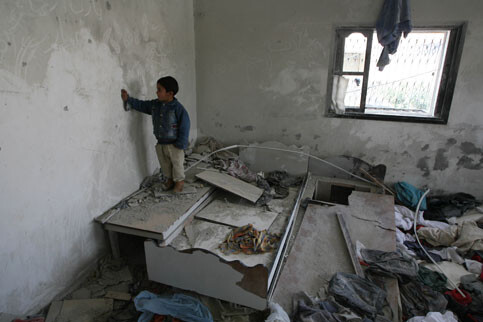Palestinian Center for Human Rights 4 March 2008

A child inspects a home Jabaliya damaged by Israeli bulldozers after Israeli troops pulled out of the northern Gaza Strip, 3 March 2008. (MaanImages)
East Jabaliya in the northern Gaza Strip bore the brunt of Israel’s latest military incursion into Gaza. The incursion, which was launched in the early hours of Thursday 28 February and lasted four days and nights. In that time Israeli troops killed 108 Palestinians, including 54 unarmed civilians, 26 of whom were children. The Palestinians who live in and around Abed Rabbo Street in east Jabaliya suffered intense air strikes by F-16 planes and helicopters, tank shelling, snipers, and having their houses invaded and vandalized by Israeli soldiers, who tied adults up with ropes, or else locked whole families into single rooms in order to use their homes as sniper towers to target local Palestinian fighters. Sixteen-year-old Jacqueline Abu Shbak and her fourteen year old brother, Iyad, both lived on Abed Rabbo Street with their mother and three other young brothers and sisters. The children’s uncle, Hatem Hosni Abu Shbak, who lives next door, found the bodies of Jacqueline and Iyad in the early hours of Saturday 1 March, when he rushed upstairs after hearing intense shooting and then screaming.
“I heard shooting and Iyad was screaming. As I ran upstairs the shooting continued, and both children were on the living room floor” he says, sitting in the blood-stained living room where Jacqueline died and Iyad was critically injured. “I tried to revive them, but Jacqueline was dead, and even though Iyad was alive and making sounds we could not save him. We had to wait for an ambulance because my car had been shelled by an Israeli tank.” Hatem Abu Shbak shows us the mirrors and windows shattered by bullets, the bullet holes in the walls, and the children’s blood on the furniture.
The Israeli soldiers who killed Jacqueline and Iyad had occupied the opposite house, and were holding Ramez Etbail and his family hostage so they could use the house to shoot at local Hamas fighters. The Israelis fired straight through the kitchen window of the Abu Shbak house, striking Jacqueline and Iyad who were both cowering in the corner. Their mother was in her own bedroom trying protecting her youngest child from the onslaught of bullets.
The children’s father, Mohammed Hosni Abu Shbak, works as a security guard in Ramallah, in the West Bank. He has been in Ramallah since Hamas’ takeover of the Gaza Strip in June 2007.
As soon as the Israeli military withdrew from northern Gaza, at around 6:00am on Monday 3 March, people came out onto the streets of Jabaliya in order to start to bury their dead. Driving through Jabaliya just hours later, funerals were being held in street after street.
Israel has described its incursion into Gaza as a “routine” military operation. However, the Israeli military’s intentions were made clear prior to the incursion, when Internal Security Minister Avi Dichter stated that unlawful rocket fire by armed Palestinians must be stopped “irrespective of the cost to the Palestinians.”
The use of excessive lethal force, and the targeting of civilians during a military operation are both illegal under international human rights law including the Fourth Geneva Convention. Jabaliya is one of the most densely populated places on earth, which makes it impossible for Israeli troops to distinguish between military targets and civilians. Israel’s deliberate and continual use of excessive lethal force in densely populated areas of the Gaza Strip has killed 237 Palestinians, including 128 civilians in the Gaza Strip this year.
Majid Abu Jelhum lives in a small quiet street about a kilometer from Abed Rabbo Street. On Saturday morning Majid and his wife were inside their house whilst four of their young children were playing in the garden. The area was quiet — Majid says there had been no fighting near his home and he thought his children would be safe in their own garden. At around 8:30am he heard an explosion, and his young son cried out for help.
“I ran to the garden, and Selsabil was on unconscious the ground; she’d been hit by a small rocket.” Selsabil’s two young sisters, and her brother who had cried out for help, were also injured by the rocket strike. The four children were rushed to Shifa Hospital in the Gaza City, which has been overwhelmed with deaths and injuries throughout the Israeli incursion. Selsabil died half an hour after arriving at Shifa hospital. She was two years old.
There are many other equally horrific cases of children having been killed during this supposed routine military operation. On 28 February, four young cousins were struck by Israeli rockets while playing football in an open area near their home in al-Qerem Street, East Jabaliya. The four children, nine-year-old Mohammad Na’im Hammouda, eight-year-old Ali Munir Dardouna, twelve-year-old Dardouna Deeb Dardouna and fourteen-year-old Omar Hussein Dardouna were dismembered by the rockets. Mohammed’s father, Naim Hamouda, told Ibrahim Sourani, a human rights lawyer at the Palestinian Centre for Human Rights, that when he found the four dead children, he could not identify which one of them was his son, because the bodies had been completely torn apart.
Israeli Prime Minister Ehud Olmert has threatened that the military operation is not over, but has merely been suspended and will be resumed. The civilian population of the Gaza Strip, including the stunned residents of Abed Rabbo St., are waiting to see whether Israel will launch more attacks against them — and hoping the outside world will meanwhile finally speak out on their behalf.
This report is part of the Palestinian Centre for Human Rights’ Narratives Under Siege series.
Related Links